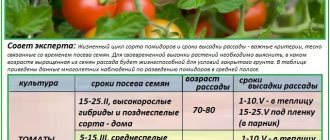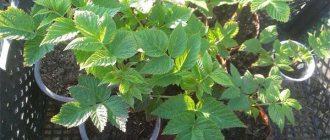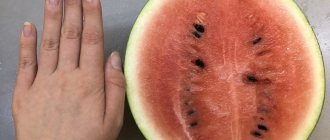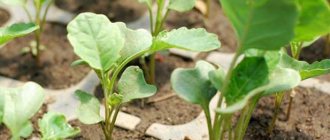10111
Rarely does a garden plot do without raspberries, but the presence of powerful bushes is not always the key to a rich harvest. If you are not happy with the size and quantity of berries, you have to plant a new raspberry tree. In this case, they decide when to transplant the raspberries to another place and how so that they quickly take root.
Seedling in its second year of growth
Why do you need to replant raspberries to a new place?
Transplanting is a very standard garden care procedure for raspberries. It is recommended to perform it every five years. The main goal of replanting a shrub to a new location is to obtain a bountiful harvest of good quality and quantity.
If we look at this issue in more detail, then we can say that transplanting raspberries to another place is necessary for the following reasons:
- During the growing season (including fruiting), a garden crop regularly takes nutrients from the soil on which it is grown. Thus, the soil is gradually depleted. Low nutrient content leads to a decrease in the quantity and quality of the harvest (quantity, taste, sweetness of berries).
- The procedure solves the problem of excessive planting density, which inevitably arises in the process of growing in one place (due to the growth of the plant). Thickness increases the risk of disease and pests.
- “Moving” to another place generally renews the bush, which has a beneficial effect on its health and productivity.
- The care procedure also performs an aesthetic function: after planting, the raspberry tree becomes neater and more well-groomed.
How do you know when it’s time to replant your plants?
Many gardeners are in no hurry to look for a place for a new raspberry tree, believing that after planting the berry no longer needs anything. However, under natural conditions, the roots of this plant actively “spread” underground. This way they give life to new shoots on more fertile, non-depleted soil. This means that when already planting bushes, it is worth thinking about where in a few years the strongest shoots with the best characteristics of the varieties will be transplanted.
Care should be taken to start preparing the soil if:
- the berries have become noticeably smaller;
- the number of fruits has decreased;
- the taste has become much worse;
- bushes are attacked by pests;
- almost no new viable shoots.
Attention! It is necessary to begin work immediately if the crop degenerates, turning into a green bush without flowers and berries.
Densely intertwined roots are usually unable to develop underground. They begin to grow almost on the surface, suffering from sunburn and temperature changes. This weakens not only the bush, but the entire plantation. Raspberries become vulnerable to various diseases.
When is it better to replant raspberries: in spring or autumn?
It is completely normal to replant shrubs in both spring and autumn. Many gardeners and gardeners believe that it is better to replant raspberries in the fall , because during this season the plant tolerates “moving” more easily, takes root faster and better, and adapts to a new place.
However, the success of the procedure is determined for the most part not by seasonality, but by compliance with deadlines, schemes and rules. If everything is done correctly, then both in spring and autumn the bush will survive transplanting well.
Note! The choice of season for a gardening event is also influenced by the growing region.
For example, in the middle zone (Moscow region) and in the southern regions, it is optimal to replant in the autumn (although the spring procedure is not prohibited!)
But in colder regions, for example, Siberia, the Urals, the North-West (Leningrad region), it is better to perform the procedure in the spring. Since there is a risk that the plant will not have time to take root in the fall, which means it may freeze out when frost occurs.
Optimal timing for transplanting raspberries to a new location in spring
Compliance with optimal timing is very important for this gardening procedure. Thanks to this, the plant will be able to change its “place of residence” without unnecessary stress and any problems with adaptation and rooting.
The timing of transplantation in the spring is determined by the condition of the plant: before the raspberry buds open . To be more specific:
- in the middle zone (Moscow region) - optimally transplant at the end of April;
- in Siberia, the Urals, the North-West - it is better to do this no earlier than the beginning of May;
- in the Southern regions - at the end of March.
The 2022 Lunar calendar will also help you choose the most optimal time for a spring transplant:
- Favorable days: in March: 8-11, 13-15, 17-23, 26-29;
- in April: 5-7, 9-11, 19, 20, 23-25;
- in May: all days except 14-16 and 28-30;
- in June: 4-6, 8-11, 19-23;
- Unfavorable days: in March: 1-3, 16, 30;
- in April: 15-17, 29, 30;
- in May: 14-16, 28-30;
- in June: 12-14, 29.
Where to replant raspberries: choosing a different place
The place of cultivation directly affects the quality and quantity of the berry harvest. That is, if you plant a garden crop in the wrong place in the open ground, you shouldn’t even hope for good fruiting.
Raspberries should be replanted in a place that meets the following criteria:
- The territory is fully illuminated by the sun (it will be ideal if the sunny location is slightly shaded at midday). Growing in the shade is not allowed.
- The place is protected from cold, strong winds.
- At the same time, the site is not located in lowlands, waterlogged and swampy areas, as well as in places where moisture accumulates.
- The quality of the soil is also important: the soil must be nutritious, well-drained, and have neutral acidity (pH 6.5-7.0).
- Loamy or sandy loam soil that meets the qualities indicated above is well suited.
- It is advisable to plant the crop in the area where legumes, onions, garlic, cucumbers, zucchini, and green manure previously grew. Thus, the principles of crop rotation will be taken into account.
How to properly prepare the site and holes for transplanting raspberries
Transplanting raspberries onto previously prepared soil and properly made holes will have a very beneficial effect on the survival rate and adaptation of the shrub, and on its fruiting in the future.
Preparing the soil on the site
Ideally, a bed for raspberries in another place should be prepared in the fall. If you did not have time to do this in the autumn, then you can prepare it in the spring (preferably 1-1.5 months in advance, or at least a couple of weeks).
Preparing the soil for replanting is as follows:
- Digging is carried out to a depth of 30-35 centimeters (bayonet shovel). When digging, rhizomes of other plants and stones (if any) should be removed.
- Before digging, it is necessary to apply fertilizers: Complex mineral fertilizers, for example, Nitroammofoska (contains nitrogen, potassium and phosphorus). Or add Superphosphate and Potassium Sulfate (potassium-phosphorus fertilizers), and then a few weeks later Urea or Ammonium Nitrate (a source of nitrogen), these drugs should not be applied at the same time. Any fertilizer is applied according to the instructions.
- And also organic fertilizers: well-rotted compost or humus: 6-8 kilograms per 1 square meter of bed.
By the way! Mineral and organic fertilizers can be applied not by digging, but directly into the planting holes (trench) in a small handful. For example, it is optimal to add a handful of Nitroammofoska and humus/compost. Be sure to sprinkle the fertilizer on top with a five-centimeter layer of ordinary soil so that the roots do not get burned!
- If the soil in the garden plot is acidic (pH below 6.0), then it is recommended to deoxidize the soil. To do this, you can add a special soil deoxidizer (you can buy it at a garden store) or add dolomite flour during digging (at an acidity below 4.5pH, about 500 grams per 1 square meter, at a pH of 4.5-5.2 - 400- 450 g, at pH - 5.2-5.5 - 300 g). However, this should not be done simultaneously with the application of mineral fertilizers, but in advance, preferably ahead of the season (that is, if the procedure is in the spring, then deoxidize in the fall).
Making holes for planting
There are 2 ways to plant raspberries:
- Bush method , that is, in separate holes. To transplant using the bush method, holes are dug in the garden bed (about 30-40 cm in diameter and depth), the gap between the holes is 50-70 cm, between the rows - 150-200 cm.
- Trench (or belt), that is, in a common trench. To transplant raspberry bushes using the trench method, you need to dig a trench (its depth and width is about 30-40 centimeters), the distance between the trenches is 2 meters. The normal length of one trench is 150-200 cm (it turns out that three or four seedlings can be placed in such a trench with an interval of 50-70 centimeters).
When digging planting holes or trenches, the top fertile layer (the first 25-30 cm) should be placed in a pile. This kind of soil will come in handy when planting!
Rules for planting remontant raspberries
In order to get a good raspberry harvest, it is important not only to choose a sunny area and prepare the soil, but also to buy healthy seedlings with a well-developed root system. It is important to consider how close the groundwater is and what the composition of the soil is . The raspberry root system grows no more than 35–40 cm, so the plant grows normally and bears fruit when groundwater occurs at a depth of 1–1.5 meters. But raspberries will definitely not grow in a swamp. If the planting area is damp and swampy, to improve drainage it is recommended to add sand to the soil (at the rate of 1 bucket per 1 m2), and broken bricks and river pebbles (10–15 cm layer) to the bottom of the planting hole, and organize raspberry planting in the spring . In the spaces between the raspberry rows on the sides, iron sheets or slate are buried to a depth of 40-50 cm to limit root growth.
To prevent raspberries from “scattering” around the site, when planting, sheets of slate are dug in along the beds
On chernozem, buckwheat or sunflower husks are added to improve aeration and air exchange in the soil, and Kemira and Nitroammofoska are added to sandy loam soil to enrich them with minerals and microelements according to the instructions (during spring planting). It is undesirable to feed shrubs with fertilizers containing chlorine; this can cause chlorosis (yellowing of leaves, accompanied by weak shoot growth and a decrease in plant yield).
Choosing raspberry seedlings
Healthy seedlings are the main condition for obtaining complete planting material. Raspberries are susceptible to infection by viruses and are often damaged by spider mites. It is desirable that the mother material:
- had high winter hardiness;
- was distinguished by high yield;
- had good resistance to diseases and pests.
High-quality seedlings have from two to four shoots 5–8 mm thick, the fibrous root system is flexible, it is almost impossible to break root hairs, and the rudiments of adventitious buds grow upward. Before planting, cut off the dried roots and soak the seedlings in water for 48 hours.
When purchasing remontant raspberry seedlings, you should pay attention to the root system; it should be well developed and have accessory buds
In mid-summer, adventitious buds are formed on raspberry rhizomes, which are characterized by slow growth.
By the autumn cold they germinate, remaining in the soil until spring in the form of colorless sprouts. In spring, growth resumes and fruiting shoots appear. Therefore, when purchasing a raspberry seedling at any time of the year, it is advisable to make sure that rudimentary shoots are present in the root system of the seedling. AlexeyT
https://forum.vinograd.info/showthread.php?t=2455
The buds on the shoots should be green and fragrant when crushed with your fingers. If the leaves bloom, they do not darken (without yellowing) and do not fade (for this, a freshly dug seedling is placed in a plastic bag with wet peat and regular spraying is carried out when storing the shoots). The right thing to do is to purchase planting material from nurseries and trusted manufacturers.
Where on the site is it better to plant remontant raspberries?
Choosing the best planting location is the key to an annual stable harvest. For remontant raspberries, choose a sunny, well-warmed place without drafts and close proximity to tall trees shading the raspberry tree. When placing this crop on a plot, it is worth remembering that remontant varieties do not tolerate prolonged drought and heat, since the root system located on the surface does not have time to support powerful shoots when there is a lack of moisture. A little shade in hot climates won't hurt. But everything should be in moderation, since if the plantings are heavily shaded, the berries will become smaller and sour, especially with a repeat harvest at the end of summer.
It is better to prefer a low-lying area to a hill with fertile black soil or light sandy loam. This berry bush gets along well with blackberries, honeysuckle, chokeberries, apricots, cherries and plums, as well as with vegetable crops - cucumbers, potatoes, carrots, and melons. Calendula, garlic, marigolds, basil and other aromatic herbs do not interfere with the development of raspberries, but repel pests with their smell.
Remontant raspberries get along well with many fruit and berry crops and vegetables on the site
Some gardeners believe that the best neighbor for raspberries is an apple tree; it inhibits the development of gray rot on the bush, and sorrel prevents raspberry shoots from “spreading” throughout the garden plot.
The proximity to currants and strawberries is considered unfavorable, because remontant raspberries have common enemies with these berry bushes - the weevil beetle and spider mites. It is believed that the close proximity of these plants can provoke the spread of these pests in the garden.
The soil should be neutral or slightly acidic. If wheatgrass, quinoa, and clover are found on the site, then the acidity of the soil is normal. When the beds are filled with horsetail, sedge, plantain, and moss, it is easy to understand that the soil has become acidic. To determine the acidity of the soil, it is not necessary to use litmus. You can use improvised means, such as baking soda or vinegar.
Mix soil and water in a small container. Sprinkle plenty of baking soda on top. If hissing appears and the slurry bubbles slightly, the soil is acidified, and measures must be taken to neutralize it.
Berry bushes require organic feeding, so when planting, add at least 15–20 kg of rotted manure per 1 m2. Wood ash (0.5 kg per 1 m2) or limestone flour is used in the same calculation to normalize the acidity level of the soil.
A turf soil mixture with the addition of coarse sand and peat (1:1) is best suited for planting remontant raspberries. To increase fertility in the fall, the top layer of soil is mulched with horse or cow manure in a layer of 10–15 cm. Over the winter, the fertilizer overheats, releasing useful microelements to the plant. Periodically (2–3 times per growing season) the berry bushes are fed with liquid complex fertilizers.
Planting scheme for remontant raspberries
There are several options for planting raspberries on the site, each of which has its own characteristics. When planted correctly, raspberry care is minimal.
Bush method
Plants are planted on the south side of the garden, in the corner area, where there is a fence or wall for support and protection from freezing. Leave 70–90 cm between plants, digging a planting hole 50 × 50 cm. The amount of fertilizer is calculated differently for autumn and spring planting (see below).
Recent Entries
Lilac perennials that are beautiful, compact and do not crowd out other plants Why when buying seedlings you should not take the sellers’ word for it and how to determine the age of the plant using 3 signs Tomato seedlings have turned purple or whitish: why the color has changed and how to save the plants
When bush planting, raspberries are placed in separate holes filled with fertile substrate
Water the raspberries abundantly and try to shade them. It is better if raspberries planted by bush method grow in areas protected from dry winds. The bushes are arranged in groups of four or six in a checkerboard pattern. As a rule, plants are loosened and weeded by hand, and to support fruit-bearing shoots they are tied to wooden or metal pegs installed closely (1–1.5 m in length).
Trench (tape) method
Planting in a trench is popular for industrial raspberry cultivation. With this technique, it is convenient to mulch the shrubs with rolled non-woven material, as well as loosen and treat the weeds from the rows mechanically (using a motor cultivator). Planting in a trench is suitable for sandy soils with a lack of moisture in the upper layers of the soil.
In the fall, the site is dug up, cleared of weeds, and filled with rotted manure (up to 20 kg/m2). By spring, the manure has rotted and all you need to do is dig trenches, add mineral fertilizer, water and shade the plantings. When planting raspberries using the trench method, you can use single-line planting - in one row, or double-line planting - in two rows with a distance of half a meter between them.
The trench method involves planting raspberries that are prone to thickening in one row.
It is convenient to plant tall varieties in two rows - this simplifies the care of the beds and saves space in the garden plot. Maintaining a distance between bushes (at least 50 cm) will avoid thickening.
Arranging raspberries in two rows is used for ease of planting care.
The trenches are located from north to south, the beds with raspberries should warm up well. The eastern or southeastern part of the garden, on the northern side of which there are buildings, is perfect. They will protect raspberries from drafts and cold winds.
As the shoots grow, they are tied to a wire trellis secured to poles. They are dug in, maintaining an interval of three to five meters. The next year after planting, another row of wire is added, 30–40 cm higher than the previous wire fastening. This will provide stronger and more reliable support for fruiting shoots. The branches are tied at a distance of 10–15 cm from each other using twine or copper wire.
As the raspberries grow, they are secured to a wire trellis using twine or wire.
When planting in autumn using the trench method, remontant raspberries are planted more densely, since not all shoots can take root before the first frost. There is an opinion that berry bushes planted in trenches overwinter better.
Video: how to plant remontant raspberries
Solitaire planting
With this method, bushes are placed one at a time for decorative purposes. Large tall shoots must be secured to a trellis. To prevent the bush from falling apart under the weight of the crop, it is tied at a height of 50–70 cm from the soil surface with metal wire, which is fixed on 2–4 wooden posts up to a meter high. At the same time, raspberries form a more powerful root system, receive more light and heat, and are less susceptible to diseases and pests than with crowded planting. The bushes are formed from 6–8 fruiting shoots and watered at the root; it is advisable to mulch the surface of the planting hole well.
When placed in a solitary plant, raspberry bushes warm up better and form powerful shoots
Solitaire raspberries can decorate any corner of the garden if planted in a purchased container or flowerpot with a volume of 10 liters or more.
Solitary planting of remontant raspberries in flower pots does not limit the growth of the plant, which can become an unusual decorative element on the site
Planting raspberries on ridges
On heavy clay soil, chernozem in a wetland, it is recommended to plant on ridges - the trench is filled with wood waste and fertile layer, the bush is planted just above the soil level and carefully mulched with straw or oilcloth - a voluminous bed of two meters or more in length is obtained.
Raspberries planted on ridges avoid stagnation of water in the soil
- When planting ridges, rows 80–100 cm deep are dug. Sawdust and chopped rotted wood (knots, bark and other wood waste) are placed on the bottom, the layer of which should be 30–40 cm. The wood will rot in a year or two, fertile humus will form.
- On top of the woody layer, add soil taken from the beds, mixed with humus (10–15 kg per 1 m2) and superphosphate (150 g per 1 m2), compact it a little and water it - 2–3 buckets per 1 m2. Part of the soil mixture is left to sprinkle the seedlings. Abundant irrigation is required - the wood will be saturated with water and will give moisture to the planted bushes for a long time.
- The seedlings are lowered into the prepared hole (observing the interval as when planting in a trench - see above) and sprinkled with soil mixed with fertilizers. The plant is watered again - 5-7 liters per bush. They mulch with straw, sawdust or rotted manure, and a mound is formed on top - it warms up better, and the bush does not lack moisture thanks to the mulch and replenishment from wood.
- Along the edges of the ridge along the trench, boards or pieces of slate are dug in (the height of the fence is 30–40 cm) so that the high bed does not collapse under the influence of precipitation and winds.
Raspberries on warm (raised) beds
This planting method allows you to get an early harvest of raspberries due to the generation of heat during the decay of organic matter, without the need for additional fertilizers during the growing season.
Warm raspberry bed ready for planting
A warm bed is a fence made from available materials (slate, boards, metal sheet), about 80–90 cm high and 1.5–2 meters long.
- Dig beds 60–80 cm wide and about a meter deep. The bottom is covered with a layer of sawdust (3-4 buckets per 1 m2), soaked for disinfection with a solution of potassium permanganate - 2 g per 10 liters of water at the rate of 3 liters per 1 m2 (layer 10-15 cm).
- The next layer is soil from the site with compost and rotted bird droppings (10–15 cm).
- Next comes a mixture of leaf litter and organic matter (20 cm) with the addition of superphosphate and potassium sulfate - 80–100 g per 1 m2.
- At the very top of the warm bed, peat mixed with humus and wheat or buckwheat husk is poured - about 10 cm.
- The finished seat is watered with hot water (5–7 buckets per 1 m2).
- Then they make small depressions and plant the raspberries, compacting them thoroughly. The soil in such a bed is quite loose and quickly settles; if the bush is not covered tightly with soil, the roots will quickly become bare.
- The surface is mulched with straw.
Building a warm bed is a labor-intensive task, but it will last for many years
If raspberries are planted in the spring, the warm bed is watered with biological products (for example, Baikal) to accelerate the decay of organic matter in the lower layers. Since the soil sags over time, it is recommended to add soil in the right places. Now raspberries will grow and bear fruit even in areas with close groundwater.
It is recommended to plant raspberries on raised beds if the location of groundwater is as close as possible
Video: how to plant raspberries in a warm bed
How to plant remontant raspberries in spring
Spring planting of remontant raspberries differs little from placing ordinary raspberries in open ground. Renovators require more organic matter and mineral fertilizers when forming a planting hole; it is also recommended to strictly maintain the distance between seedlings (minimum 40–50 cm), since in one growing season they grow into powerful tall bushes.
- Before planting, the roots of the seedlings are kept in a 1% solution of copper sulfate for 5 minutes, then soaked in water for 12 hours.
- Plants are lowered into prepared holes (50 cm deep and 40-50 wide) or trenches (keep the depth similar to bush planting), filled with rotted manure (1 bucket), peat (5-7 kg), ash (500 g) per 1 m2 ) and superphosphate (100 g). Then the roots of the plant are evenly spread out and carefully covered with the prepared substrate. It is necessary to avoid excessive deepening of remontant raspberries with any planting method, so the root collar is left at soil level.
- The soil is trampled down around the seedling with progressive movements, 1-3 buckets of water are poured under each plant (depending on the soil and weather), mulched well: natural materials are suitable for this - foliage, pine needles, sawdust, hay and straw, as well as a non-woven covering (for example , lutrasil), roofing felt or oilcloth is often used for these purposes. This is necessary to protect the soil surface from drying out in the spring.
- When planting raspberries, the bushes are not pruned too much - cuttings 15–20 cm high (2–3 buds) are left above the ground surface, cut diagonally with sharp pruning shears.
Since there is not enough moisture in the spring—the plants find themselves in hot, dry conditions after planting—remontant raspberries need to be watered more often during spring planting than in the fall. During the week at least twice - 2-3 buckets per 1 m2. Only in the case of early planting (mid-March), when the soil is saturated with melt water and hot weather has not yet set in, does the seedling need abundant watering.
If plants are planted correctly, they will quickly grow
Planting remontant raspberries in autumn
- Add 50 g/m2 of potassium sulfate, 15 kg of humus and 80 g of superphosphate in granules to the soil mixture for planting. In the fall, eliminate nitrogen supplements. Before planting, the roots of raspberry cuttings are soaked for 3–5 hours in a mash of clay, mullein and water in a ratio of 1:1:1, to which any insecticide is added (for example, 30 g of Aktara). The drug protects raspberry seedlings from soil pests that overwinter in the upper layers of the soil.
- Then the cuttings are lowered into planting holes (50x50 cm, 60–70 cm deep) or trenches (see above), the roots are evenly spread, covered with the prepared substrate, slightly pressing the soil around the seedling. The root collar is slightly deepened (by 2–3 cm). In autumn, raspberry cuttings are cut as short as possible (1–2 cm of shoot are left). This pruning prevents premature germination of buds during autumn warming and freezing of shoots during severe frosts.
- Plantings are watered at the rate of 10–15 liters of water per 1 m2 once a week. In autumn, abundant irrigation is not required.
- Raspberries are mulched with straw or sawdust, covered with thin dry branches or small pine deadwood. Snow retention is the main function of such mulch. Snow cover is a natural insulation for remontant raspberries in winter.
In the fall, after planting, raspberries are thoroughly mulched.
The main difference between planting remontant raspberries in the fall: at the end of the procedure, pruning of the shoots at the root is required.
In the Central Black Earth Region, we usually plant remontant raspberries in the fall. On my site there are specimens planted in both autumn and spring. These plants develop in exactly the same way, the only difference is that spring plantings can produce the first harvest as early as July of the current year. Most often, new varieties purchased from a nursery are planted in spring. From the end of August to mid-September, I thin out my own raspberry tree and transplant the well-developed, almost lignified young shoots of the remontant ones to a new location, that is, I increase the area of planting remontant raspberries at the expense of my own shoots. This allows you to save on the purchase of new seedlings. In addition, your own young cuttings rarely get sick and quickly take root.
On my plot of land there is gray sand (the same as what happens in a forest - it is located not far from our house). Considering that remontant raspberries love the sun and warmth, I plant them in open, heated beds. A significant disadvantage of planting on sand is the rapid drying out of the soil. You pour water “like a sieve”; sometimes even mulching the root space with straw, pine litter, sawdust and dry branches does not help. For myself, I found a way out of the situation: when planting raspberries (grapes and fruit trees as well), we lay pieces of slate closely at the bottom of the hole (50–60 cm deep), and pour broken crushed stone (smaller) on top. Then comes the standard filling of the planting hole - bark and tree branches, compost - about half a bucket, the same amount of fresh manure with the addition of ash (500 g per hole). Be sure to sprinkle two or three handfuls of purchased complex fertilizer for fruit and berry bushes (for example, superphosphate). I mix everything, make a hole in the soil mixture and plant the bush with minimal deepening of the growth buds. This method of planting serves as a salvation from loss of moisture on the soil surface, which is especially dangerous in the first days after planting in the spring. I water the plantings at the rate of 7–10 liters of water per bush. Since raspberries love fertile soil, I mulch the root space on top with rotted manure (1 bucket per bush). Regardless of the time at which remontant raspberries are planted, this procedure is useful for two reasons: a dense layer of manure mulch retains moisture no worse than straw or non-woven material, and when dissolved, it gradually enriches the soil with nutritious organic matter.
Video: how to plant remontant raspberries in the fall
Caring for remontant raspberries after planting
- It is recommended to water the raspberry tree when the soil dries out in hot weather - at the root, when it is cloudy - to sprinkle, this will avoid burns on the young foliage. You should think through and properly organize the irrigation system: if possible, set up drip irrigation, also rain irrigation or root watering on slopes.
- At the end of summer, watering is reduced so that the plants ripen and develop well. Fertilizing is carried out at least twice during the summer: before buds open and 2 weeks before flowering.
- Powerful shoots are tied up or secured to a trellis.
- They also remove root shoots that take away nutrients: trim with a sharp shovel at a depth of 7–10 cm.
Autumn pruning of fruit-bearing shoots is carried out as late as possible so that the roots absorb all the useful microelements. This increases the frost resistance of the plant.
Every year, for the purpose of prevention, remontant raspberries are treated against pests and diseases with systemic combination drugs - Fufanon, Topaz, Inta-Vir, Oxyx, and Fitolavin, which is safer in composition.
Video: caring for remontant raspberry varieties after planting
Preparing raspberries for transplanting: mandatory pruning
Preparing the bush for replanting is very important (relevant for both autumn and spring procedures)! The fact is that the bush has a single root system (the main bush and its root shoots). When digging up a plant, the roots will be damaged in one way or another. Therefore, it is very important that after the procedure the plant directs its precious resources to the restoration and development of the root system, and not to the growth of green mass (shoots, leaves). Otherwise, the active growth of green mass will adversely affect the rooting and survival rate of the bush.
So, the basic principle of preparing for transplantation is as follows: before digging, you need to trim the shoots, shortening them to 40-60 cm in height.
Features of spring transplantation
The process of transplanting raspberries in spring has several features. So, it is required that the plant has time to:
- take root;
- grow a stem;
- lay fruit buds;
- form a replacement bud on the root system for the next season;
- form adventitious roots.
Only then will the raspberry bush bear fruit.
Important. It is necessary to start replanting immediately when the snow melts and good weather sets in. Frost can kill a raspberry bush if it is replanted immediately. Also, before planting the crop, the soil must be disinfected.
A step-by-step scheme for transplanting an adult (old raspberry) to a new place in the garden
It is advisable to replant only the healthiest, strongest and strongest bushes. There is no point in worrying about damaged, weak, disease- or pest-affected plants! The following diagram will help you transplant raspberries correctly:
- Dig up the bush from the old place: carefully dig it in a circle with a slight indentation from the trunk. The position of the shovel when digging should be strictly vertical (this way, damage to the roots can be minimized; if the blade is positioned at an angle, the main roots can be damaged).
- Very quickly move the dug up bush (the plant along with the soil around the root system) to a new location. You need to replant very quickly, the survival rate of the plant directly depends on this; if a dug-out bush is left in the open air for a long time, it can weaken and then take root worse. If a situation arises that you need to transport a dug up bush from one place to another (for example, from the site of a private house to a country house), then immediately after digging, you should wrap the lump of earth with agrofibre or thick paper, moisten the material and put the lump in a bag.
- Further steps now depend on which method of transplantation you are interested in: conventional or with propagation by dividing the bush. Transplantation with propagation by dividing the raspberry bush. After digging, you need to carefully divide the bush into several parts with your hands (if you can’t do it with your hands, you can do this with a sharp, disinfected knife). Each part should have two or three strong and healthy shoots with developed roots. After dividing the bush, you need to straighten the roots, place the seedling in the hole, the roots should lie flat and not bend upward. It is necessary to plant at such a depth that the root collar is level with the ground or 2 cm below the ground level, not lower!
- When replanting raspberries normally without dividing the bush, you should simply place the seedling in a hole with a whole dug up lump of earth. The root collar must be level with the ground surface!
- Fill the hole with the plant with fertile soil, which you put aside in a separate pile (or ordinary garden soil).
- Seal the area around with your hand.
- Water abundantly.
- Inspect the area after a few hours; when the soil settles, you need to fill it up to the previous level.
- Place a wooden stake for garter next to the transplanted bush, but it should not damage the roots! Tie the plant to it with twine so that in case of bad weather (strong wind, rain) it will not tilt during the rooting period. In this case, the string should not be pulled too tightly and rub the trunk.
- Mulch the planting site with a layer of about five to seven centimeters (there should be a gap of several centimeters between the mulch and the plant trunk). Rotted sawdust, peat, and humus can be used as mulch.
How to replant raspberries with root shoots (sprouts)
Root shoots (or root shoots) are new shoots growing from accessory buds at a distance of about 0.3-0.7 m from the main bush. And these same buds, in turn, are located on the horizontally located roots of the bush.
In spring, green root shoots are transplanted, having reached a height of about 15-25 cm. Transplanting raspberry root shoots is in many ways similar to the procedure carried out with an adult bush. You also need to carefully dig up the plants and move them to a new location.
The first time after the procedure (7-10 days) it is necessary to shade the plants from direct sunlight. For example, you can place arcs on the sunny side and stretch agrofibre, a sheet, or burlap over them.
Advice! It is no secret that any transplantation or propagation by dividing a bush causes stress to the bush to one degree or another (especially dangerous if the roots have been severely damaged). To reduce stress and improve survival rate, it is recommended that after watering with regular water, pour a solution of a growth and root formation stimulator, for example, Kornevin, under each plant in the open ground. It is important to use any such drug according to the instructions.
As you can see, changing the “place of residence” of a berry bush within one garden or transporting and transplanting from one site to another is not such a difficult undertaking. You can do this in the spring, or wait until the fall, whichever is more convenient for you. The main thing is to follow all the rules.
Optimal time
Having determined by the condition of the shrub that it is time to replant, you need to choose the most suitable time for this. Each gardener, both amateur and professional, chooses his own option. They are guided by the deadlines they want to meet, the time of year and the readiness of the place for a new berry garden.
Spring
Early spring replanting is suitable for regions with warm and humid off-seasons. It is chosen when it comes to non-remontant raspberries, the harvest of which can only be seen in a year. This season is also supported by the saturation of the earth with moisture, organic matter and minerals formed under the snow cover. The summer months are enough for the bushes to take root and the first shoots to appear. With the onset of spring, both young shoots and mature plants are transferred to a new location.
Summer
In the summer, young shoots are transplanted to a new place, giving them the opportunity to take root in the new place and gain strength. Bushes with an overgrown powerful root system are very difficult to transplant. Therefore, take strong root shoots of approximately the same age. Their roots grow close to the surface, so the rest of the bushes will not be damaged. The summer option of replanting plants is considered the most difficult.
Pros and cons of summer transplantation
The undoubted advantages of carrying out the procedure at this time of year include predictable weather conditions. It is possible to prepare the soil and monitor how the young seedlings have taken root and are growing. In winter the bushes will leave strong, ready for stressful conditions. And in the spring it will be possible to plant new shoots where for some reason the raspberries died.
Among the disadvantages are the same weather conditions, especially in the risky farming zone:
- The scorching sun can burn the foliage of young plants in a new location.
- Heavy rains can wash away the soil.
- Differences in night and day temperatures are also detrimental to delicate shoots.
- The rain, which was replaced by suffocating heat, will destroy the seedlings, creating a greenhouse effect and literally cooking the raspberries.
- Morning dew is no less harmful to plants that find themselves without the protection of their mother bushes.
When deciding to plant raspberries in a new area in the summer, you should take into account all the nuances. For planting, you need to choose a day that is not hot, preferably cloudy. Start work when the sun is already setting, this reduces the risk of burns. In the coolness of the night, it will be easier for seedlings to endure the first stress. But if the next day promises to be hot, then in the morning it is worth shading the bushes.
Autumn
According to tradition, autumn is considered the best time of year for replanting fruit bushes. September and the first half of October are the time when the earth is moistened and the sun warms gently, without burning. These months are favorable for both young shoots and mature bushes to take root. Having completed fruiting, the plant prepares for winter rest, sheds its leaves and all processes slow down. This is what will help him spend the winter under the snow, gain strength so that in the spring he can produce several strong shoots.











